The installation of a transformer station in a plant includes the design, construction, and setup of electrical systems to meet production requirements, encompassing everything from site surveys to routine maintenance.
Overall Process for Transformer Preparation and Design
The initial phase involves site suitability assessments, comprehensive technical design, and material readiness before starting the building and installation steps.
Project Organization and Logistics
Effective project setup is vital for cost optimization and timeline management. Start by ensuring ample construction site space and essential utility setups, optimizing labor allocation according to workload, and utilizing local materials to cut down transportation costs.
Equipment Transportation
Devices are transported through two main methods:
- Mechanical: Essential components like cables, transformers, and insulators are moved to a secure on-site warehouse.
- Manual: Small-scale materials and poles are transported manually or with basic means to ensure safety and cost-effectiveness.
Technical Design
Installation relies on detailed technical designs, outlining principal circuitry and electrical connections, supported by comprehensive drawings for foundation sizing, cable pathways, and connection methods.
Detailed Drawings
- Foundation Sizing: Essential for height, installation location of transformers, and auxiliary equipment.
- Cable Pathways: Illustrate routes and elevations for precise device connections.
- Installation Accessories: Provide specifications for bolts, mounts, and assembly diagrams.
Equipment Preparation
Before installation, rigorous inspections via catalogs and inventories are mandatory. Verify technical specifications like rated voltage and current match order requirements.
Installation Process
- Pit Excavation and Pole Setting: Foundation creation for poles and transformer bases begins.
- Steel Frame Installation: Securely positioning transformers onto steel frames utilizing jacks.
- System Connection: Ensure proper wiring, cabinet setup, and measuring devices are installed precisely.
Workplace Safety
Workplace safety during transformer station construction is paramount. Adherence to PPE regulations, including the inspection of grounding systems and transformer insulation, is crucial before operational deployment.
Documentation Requirements
Essential documentation entails legal dossiers like connection requests and approved technical diagrams, alongside manufacturer installation manuals.
Compliance with electrical standards such as TCVN and IEC for medium voltage is necessary to maintain quality and safety of transformer stations.
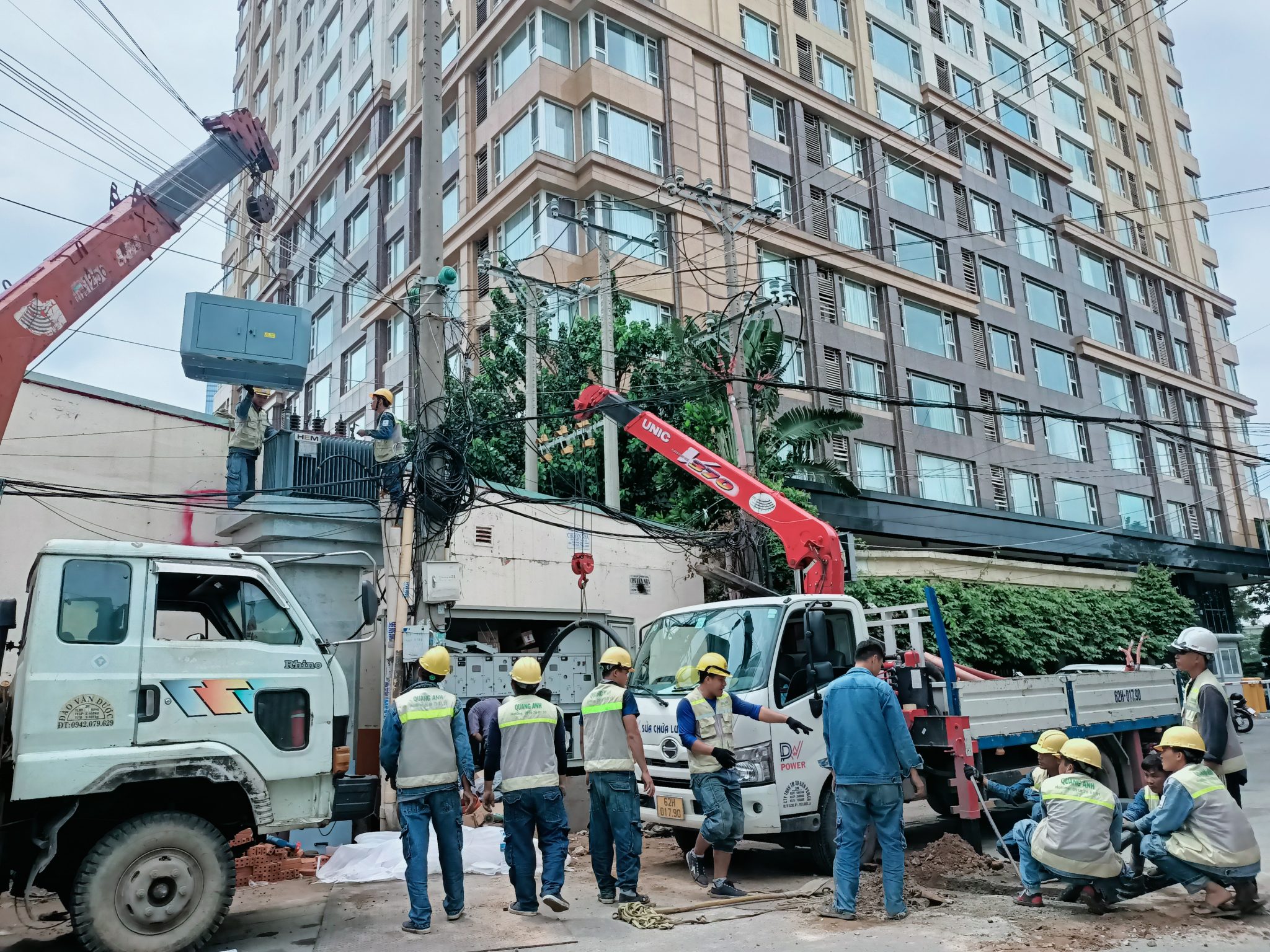
Infrastructure Construction for Transformer Station
Starting with foundation excavation, grounding system setup, and concrete foundation pouring, the infrastructure construction process sets a solid base while installing underground protection pipes to secure electrical systems.
This phase demands a meticulous and detailed approach to safeguard operational and electrical safety. Initial assessments determine precise locations for foundations and medium-voltage cables, avoiding roadways and occupied areas.
Preparation includes excavation, foundation establishment, and utility provision, ensuring efficient material and equipment transport. Grounding systems, mitigating lightning risks, are crucial to safety. Subsequent concrete foundation pouring solidifies the transformer’s operational stability.
Key electrical devices like switchgear, operation seats, crossarms, and insulators need accurate assembly for effective electricity control. Proper transformer position is essential, employing cranes for accurate setting. Integrating medium voltage cables is imperative, linking the transformer station securely to the power source while ensuring a perfect connection.
Testing, fine-tuning, and acceptance check the entire system’s reliability before client handover. Upholding labor safety and quality standards remains a priority throughout this intricate process.

Equipment Installation for Transformer Station
Building this stage involves installing switchgear, operation seats, and positioning transformers using cranes to ensure safe electrical functioning and operational efficiency.
- Site Well and Documentation Preparation: Thorough site assessments determine optimal positioning for transformer infrastructure. Legal procedures include installation registration and principal device schematics. Organized site logistics cover utility supplies and workforce deployment.
- Foundation Execution and Support Systems: Implement foundation excavation and protective pipes precisely per approved designs. Grounding adherence to electrical safety standards precedes high-grade material concrete setting.
- Main Equipment and Accessories Installation: Move transformers to prepared bases, ensuring balance and mechanical connections. Install critical devices like switchgear, operation seats, and insulators. Medium-voltage cables must be correctly routed and defect-free.
- Connection and Trial Run: Connect transformers and auxiliary systems to the grid, placing signs per safety standards. Test operational parameters, including grounding resistance and no-load current.
- Final Acceptance and Handover: Conduct final inspections ensuring precise setups, sealing raceways, and environmental readings are within limits. Perform energized and non-load trials before management handoff.
Technical Notes:
- Strictly adhere to electrical safety standards, especially lightning protection.
- Ensure material certification for cables from trusted brands: Cadivi, LS, Eaton, Schneider.
- Schedule regular maintenance, inspecting grounding systems and transformer oil for consistent functionality.
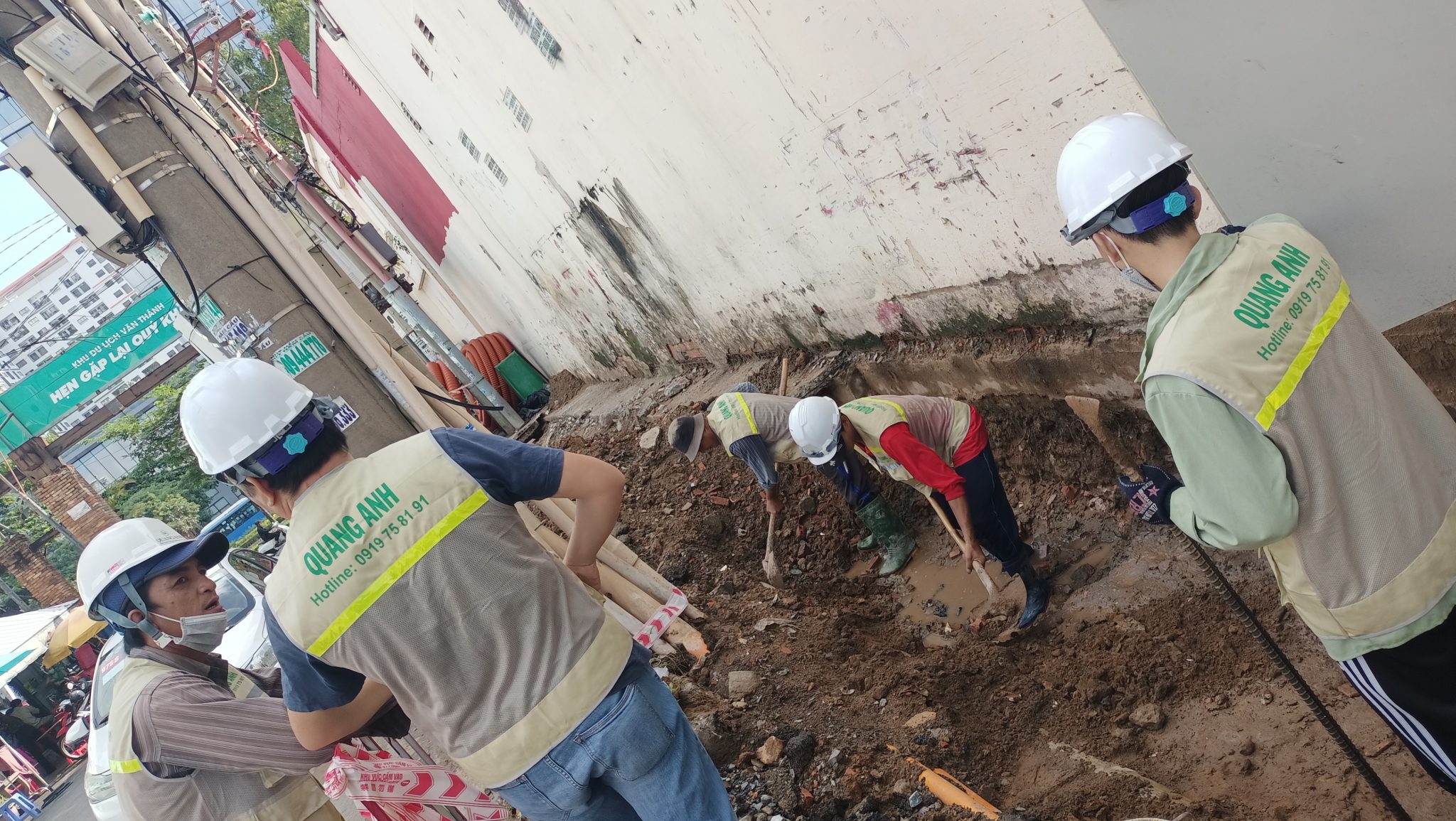
Electrical System Connection and Testing
Subsequent to equipment assembly, medium-voltage cable integration and transformer station connectivity encompass testing and tweaking for a safe, precise system before deployment.
This phase involves key steps to verify device integrity and operational safety, embracing multiple testing procedures:
- Insulation Resistance Testing: Measure insulation capacity to prevent current leakage.
- Partial Discharge Evaluation: Expose localized discharges within insulation to avert damage.
- Hi-Pot Testing: Validate devices’ high-voltage durability.
- Transformers’ Ratio Testing: Ensure accuracy in transformer and current transformers critical for grid stability.
- Ground Resistance Measurement: Assess grounding system effectiveness vital for lightning and stability protection.
System Connection Procedures
Following Decision 25/QD-DTDL (2019), the stages include:
- AGC Integration: Verify on-site and remote control through SCADA/EMS for consistent operations and rapid fault detection.
- FRS Compatibility: Secure system dispatcher reliability, maintain scheduled documentation, ensuring systematic approval.
Applicable Equipment
Testing extends to:
- Transformers/CT/PT: Analyze magnetic characteristics and resistance, confirming operational compliance.
- Capacitors: Measure current, reactive power, connections for optimal performance.
- Grounding Systems: Appraise mechanical endurance and earthing resistance for electrical safety conformity.
Testing Objectives and Standards
Upholding operational safety and minimizing risks follows legal standards like IEC 62271 and TCVN 3715 for enhanced system balance and grid reliability.
Legal Reference Documents
Key documents include Decision 25/QD-DTDL (2019), IEC 62271, and TCVN 3715 ensuring proper legal testing frameworks.
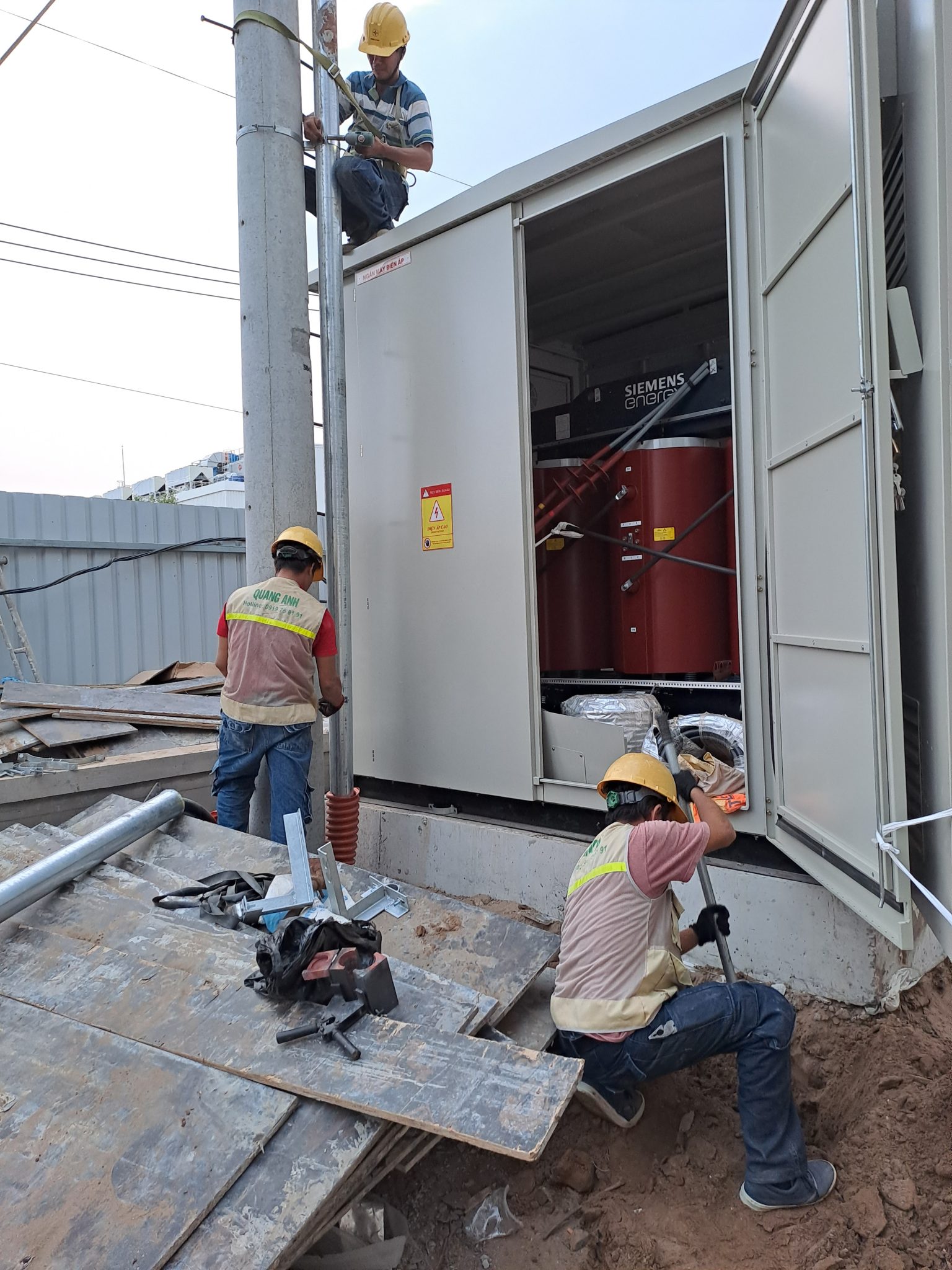
Notes and Safety Equipment for Transformer Station
Concluding with signage for transformer stations, conveying location and hazard information, alongside routine maintenance for prolonged safety and operational stability.
Transformer stations play a pivotal role in electricity grid systems, adjusting voltage for efficient power distribution across regions. Adhering to specific safety measures during operation and maintenance is indispensable.
Note Documentation
Critical notes include:
- Maintenance History: Logs all service and inspection activities to sustain equipment performance.
- Operational Guidelines: Detailing operational steps to optimize system performance.
- Incident Reports: Record issues and promptly implement corrective actions.
Safety Equipment Installation
Essential safety protocols include:
- Employee Safety Gear:
- Protective Clothing: High-visibility vests, safety shoes, and specialized goggles.
- Protective Devices: Rubber gloves and respirators safeguard against potential hazards.
- Electrical Safety Equipment:
- Main Switch: Must always be ready to cut off electricity if necessary.
- Electrical Network Diagram: Provides detailed oversight control.
- Protective Devices: Assure transmitters are correctly ground-connected to prevent electrical fire risks.
- Workplace Environmental Safety:
- Electric Fire Prevention: Fire extinguishers strategically placed, coupled with automatic fire alarm systems.
- Ventilation: Critically needed for battery rooms, preventing hazardous gas build-up.
- Technical Regulations:
- Compliance Standards: Follow standards such as Circular 38/2019/TT-BCT for maximum safety assurance.
Temporary Power Supply Works
- Cabinet Placement: Position in dry or elevated locations to avoid moisture exposure.
- Proper Grounding: Maintain grounding to minimize shock risks.
Battery System Procedures
- Safety Gear: Wear specialized clothing and gloves when handling acids and alkalis.
- No Flames or Smoking: Keep away from battery storage areas to avert explosion risks.
- Ventilation: Ensure battery rooms are well-ventilated to prevent toxic gas accumulation.
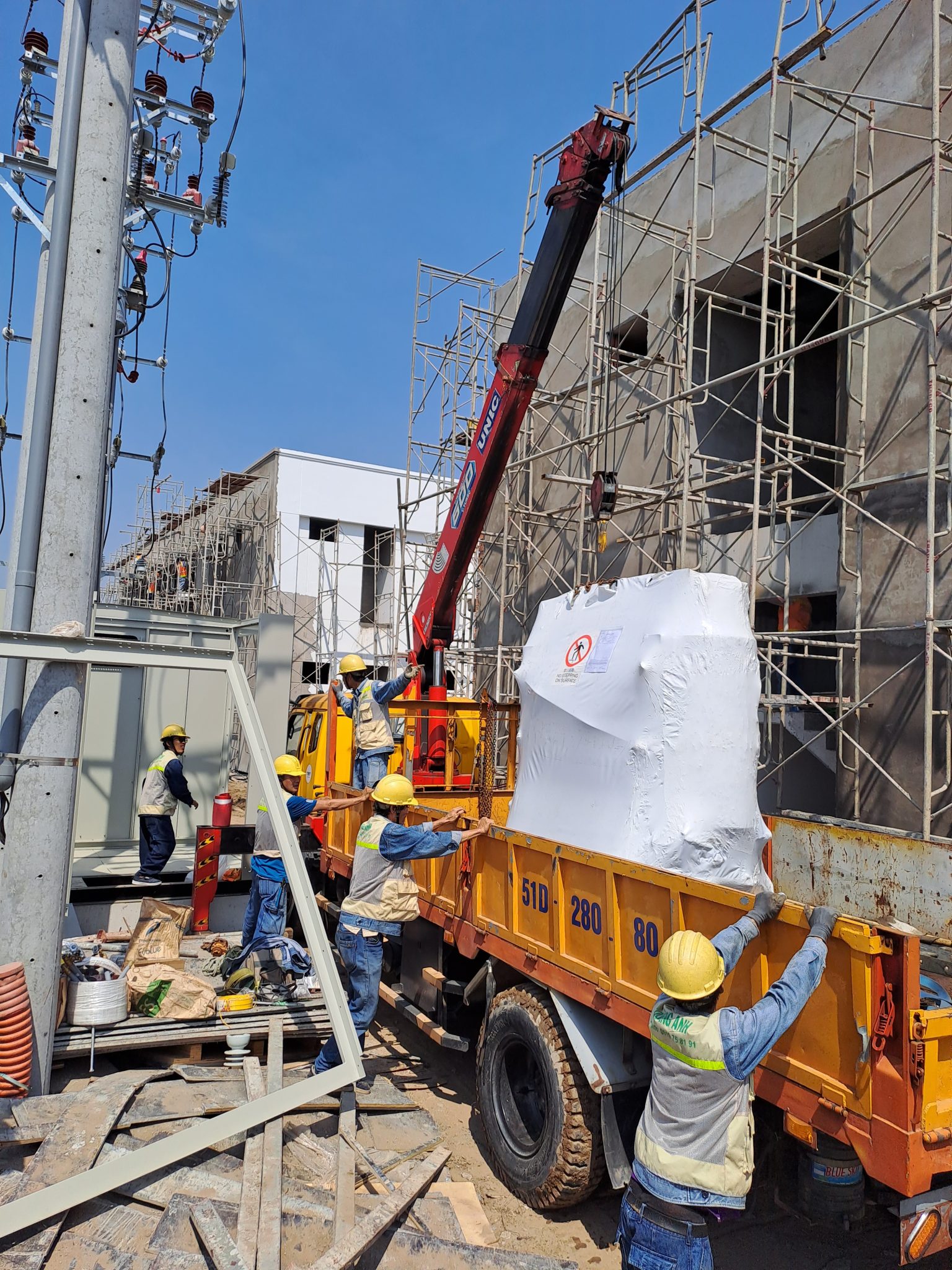
The installation of industrial transformer stations ensures steady and safe power distribution, offering superior technical advantages and optimizing long-term investments.
For transformer station projects, contact QuangAnhcons at +84 9 1975 8191 for detailed consultancy.
QuangAnhcons delivers expert industrial transformer installation services, from technical design to setup, and periodic maintenance, assuring effectiveness and safety for clients.

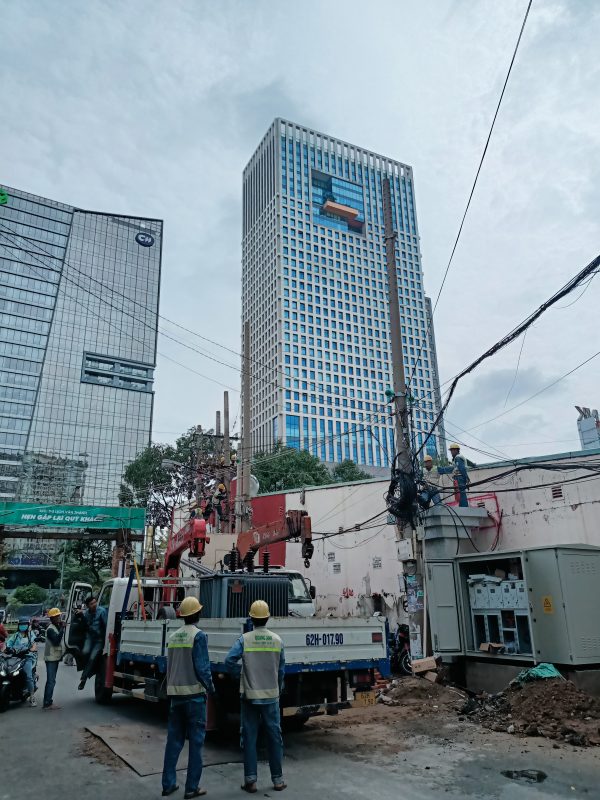
Related Posts
Factory Electrical Systems: Comprehensive Design and Implementation Guide
Discover the detailed and safe process of factory electrical systems design and implementation. [...]
Oct
Blueprints Required for Factory Construction Permits
Discover the necessary blueprints in factory construction permit applications, from floor plans to electrical and [...]
Oct
What Are the Requirements for a Factory Construction Permit? A Comprehensive Guide
Explore the documentation and steps needed to secure a factory construction permit for streamlined project [...]
Oct
Factory Construction Permit Procedures in Vietnam: Essential Guidelines and Documents
Learn the procedures for securing a factory construction permit in Vietnam, focusing on document preparation [...]
Oct
Key Steps in the Factory Construction Process
Discover the essential steps and requirements for building factories. [...]
Oct
Comprehensive Electrical Substation Solutions by Quanganhcons
Discover the cutting-edge electrical substation solutions offered by Quanganhcons for industrial applications. [...]
Oct
Investment Costs for a 1MWp Solar Power System and Influencing Factors
Explore the investment costs for a 1MWp solar power system in Vietnam and the influencing [...]
Sep
QuangAnhcons: Elevating Wind Energy Solutions
Explore QuangAnhcons' leadership in wind energy and renewable solutions in Vietnam. [...]
Sep
Electrical Contractor Strategies at Becamex Industrial Park
Discover the strategic advancements and partnerships of the electrical contractor at Becamex Industrial Park. [...]
Sep
Investment Insights for 1MW Wind Energy in Vietnam: Costs and Opportunities
Discover the detailed analysis of costs and opportunities for investing in 1MW wind energy projects [...]
Sep
Advanced Electrical Installation Solutions by QuangAnhcons
Explore advanced electrical installation solutions and modern technology with QuangAnhcons. [...]
Sep
Enhancing Industrial Electrical Services with Quanganhcons
Discover Quanganhcons' expertise in industrial electrical services, offering efficient and sustainable power systems. [...]
Sep
Comprehensive MEP Solutions by QuangAnhcons: From Design to Maintenance Excellence
Discover optimal MEP solutions with QuangAnhcons, dedicated to excellence from design through maintenance. [...]
Sep
Comprehensive Electromechanical Contracting Solutions by QuangAnhcons
Explore QuangAnhcons' comprehensive services for efficient and safe energy system solutions. [...]
Sep
QuangAnhcons: Empowering Industrial Energy Solutions
Discover how QuangAnhcons delivers optimal industrial EPC solutions. [...]
Sep
Effective Industrial Construction Management and Execution
Optimize your industrial projects from design to execution with our contractor services. [...]
Sep
QuangAnhcons: Pioneers in M&E and Renewable Energy Solutions
Discover QuangAnhcons' innovative M&E services and renewable energy solutions. [...]
Sep
QuangAnhcons: Expertise and Outstanding Services in the Electrical Sector
Discover the unmatched expertise and services of QuangAnhcons, setting superior standards in the electrical contracting [...]
Sep
QuangAnhcons: Innovation and Precision in Industrial Electrical Contracting
Discover QuangAnhcons, a top contractor offering superior electro-mechanical solutions. [...]
Aug
Expert Solutions for 2x2500kVA Substation Projects with QuangAnhCons
Explore QuangAnhCons, a forefront entity in designing and constructing large industrial substations. [...]
Aug